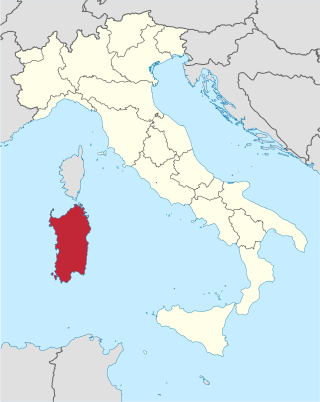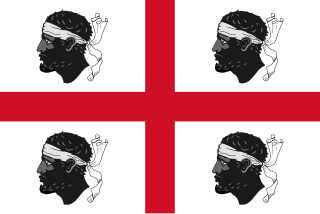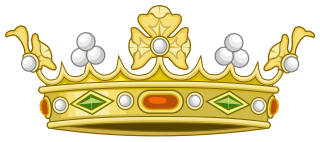Related Research Articles

Sardinia is the second-largest island in the Mediterranean Sea, after Sicily, and one of the twenty regions of Italy. It is located west of the Italian Peninsula, north of Tunisia and immediately south of the French island of Corsica.

Archaeological evidence of prehistoric human settlement on the island of Sardinia is present in the form of nuraghes and other prehistoric monuments, which dot the land. The recorded history of Sardinia begins with its contacts with the various people who sought to dominate western Mediterranean trade in classical antiquity: Phoenicians, Punics and Romans. Initially under the political and economic alliance with the Phoenician cities, it was partly conquered by Carthage in the late 6th century BC and then entirely by Rome after the First Punic War. The island was included for centuries in the Roman province of Sardinia and Corsica, which would be incorporated into the diocese of Italia suburbicaria in 3rd and 7th centuries.

Luigi Amat di San Filippo e Sorso was the dean of the College of Cardinals during the last part of the record long reign of Pope Pius IX.

Nanni Loy was an Italian film, theatre and TV director. Specifically, Nanni Loy was Sardinian, and one of several notable Sardinian film makers, including Franco Solinas.

The Kingdom of Sardinia, also referred to as the Kingdom ofSardinia-Piedmont or Piedmont-Sardinia as a composite state during the Savoyard period, was a country in Southern Europe from the late 13th until the mid-19th century.

The Sardinians, or Sards, are a Romance language-speaking ethnic group native to Sardinia, from which the western Mediterranean island and autonomous region of Italy derives its name.

Vicente Bacallar y Sanna, 1st Marquess of San Felipe, later italianized into Vincenzo Bacallar Sanna, 6 February 1669 – The Hague (Netherlands), 11 June 1726). He was a Sardinian nobleman, military officer, linguist, historian, politician and ambassador of the Spanish Empire. He was born to a noble Sardinian family when the kingdom of Sardinia was part of the Spanish crown.

Marquess of San Felipe, was a hereditary title in the Peerage of Spain and Peerage of Sardinia, granted in 1709 by Philip V to Vicente Bacallar y Sanna, a Sardinian historian of Valencian origin who served as ambassador in the Spanish Netherlands and the Republic of Genoa

The literature of Sardinia is the literary production of Sardinian authors, as well as the literary production generally referring to Sardinia as an argument, written in various languages.
This article presents a history of Cagliari, an Italian municipality and the capital city of the island of Sardinia. The city has been continuously inhabited since at least the neo-lithic period. Due to its strategic location in the Mediterranean and natural harbor, the city was prized and highly sought after by a number of Mediterranean empires and cultures.
Marquis of Villahermosa e Santa Croce is a title first granted in 1745 by Charles Emmanuel III, king of Sardinia to the Sardinian merchant Bernardino Antonio Genovès. It has passed afterwards to a branch of the house Manca, called Manca di Villahermosa since.
Marquis of Neoneli is a title granted in 1774 by Victor Amadeus III of Savoy, king of Sardinia, to Sardinian nobleman Pedro Ripoll. It has passed afterwards to the house Sanjust.
Marquis of San Sperate is a title granted in 1749 by Charles Emmanuel III of Savoy, king of Sardinia, to Sardinian judge and nobleman Joseph Cadello. It has passed afterwards to the house Ripoll and eventually to Sanjusts.
Marquis of Montemuros, also called Monte Muros, is a title granted in 1762 by Charles Emmanuel III of Savoy, king of Sardinia, to Sardinian nobleman and lord Pedro Martinez. It got extinguished in 1918.
Marquis of St. Charles is a title granted in 1754 by Charles Emmanuel III of Savoy, king of Sardinia, to Sardinian feudal Lord James Borro. It has passed afterwards to the house Palici and eventually to Cugias.

Pietro Amat di San Filippo was an Italian geographer, historian and bibliographer.
Duke of Vallombrosa was a title created for the House of Manca. The present holder is disputed.

The Kingdom of Sardinia was a feudal state in Southern Europe created in the early 14th century and a possession of the Crown of Aragon first and then of the Spanish Empire until 1708, then of the Habsburgs until 1717, and then of the Spanish Empire again until 1720.
References
- ↑ According to the common genealogical use in Sardinia (and also legal use in Spain), Marquesses are indicated with both the father's and the mother's surnames, whatever the actual form in documents.
- ↑ In order to describe the spouses' houses, main titles of those houses are indicated, in the modern Italian form «of the [title]»